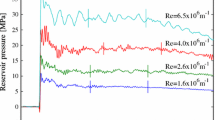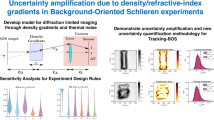Abstract
This work evaluates the potential for producing quantitative data of the density field using a two-dimensional colour schlieren system within the test section of a shock tube. Density gradient components, magnitude and direction, form the basis of the quantitative evaluation. These are encoded onto an imaging plane by means of a colour-coded source mask placed along the optical axis of the schlieren system. Direction is indicated by the relative ratios of the three primary colours: red, green and blue (RGB). Magnitude is indicated by the relative intensities of the RGB values. Sensitivity of the system is adjusted by an iris diaphragm placed in the cutoff plane. The method described is applied to the focusing of a shock wave in a parabolic cavity. The experimental results of the schlieren technique are compared to computational simulations with synthetic two-dimensional colour and magnitude coding applied to the results. The source masks designed and used proved to require a greater intensity light source and thus the design of an LED light source was developed. The CFD solutions were converted into an image format directly comparable to the photographic images obtained. Image processing techniques have been employed to deconstruct photographs to allow for quantitative comparisons with a calibration lens. Density gradient direction has been conclusive; however, density gradient magnitude is not yet accurately determined due to light source constraints.
Graphical Abstract












Similar content being viewed by others
References
Buttsworth DR, Ahfock TL (2003) A pulsed led system for schlieren flow visualisation. Technical report, Faculty of Engineering and Surveying, Queensland
Hargather MJ, Lawson MJ, Settles G S, Weinstein LM, Gogineni S (2009) Focusing-schlieren PIV measurements of a supersonic turbulent boundary layer. In: 47th AIAA Aerospace Sciences Meeting, Paper AIAA-2009-69
Kleine H (2000) Measurement techniques and diagnostics. In: Ben-Dor G, Igra O, Elperin T (eds) Handbook of shock waves, vol 1. Academic Press, pp 683–740
O’Hagan WJ, McKenna M, Sherrington DC, Rolinski OJ, Birch DJS (2002) Mhz LED source for nanosecond fluorescence sensing. Meas Sci Technol 1:84–91
Settles GS (2001) Schlieren and shadowgraph techniques. Springer, Berlin, Heidelberg
Skews BW, Kleine H (2007) Flow features resulting from shock wave impact on a cylindrical cavity. J Fluid Mech 580:481–493
Acknowledgments
The authors wish to thank Harald Kleine, Gary Settles, Mike Hargather and James Taylor for input on colour schlieren systems and help with the circuits for the light source. This research was supported by the South African National Research Foundation.
Author information
Authors and Affiliations
Corresponding author
Rights and permissions
About this article
Cite this article
Stevenson, D., Skews, B. Quantitative colour schlieren development. J Vis 18, 311–320 (2015). https://doi.org/10.1007/s12650-014-0248-8
Received:
Revised:
Accepted:
Published:
Issue Date:
DOI: https://doi.org/10.1007/s12650-014-0248-8




